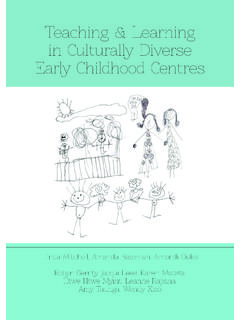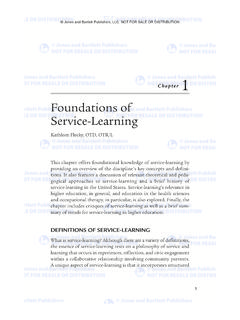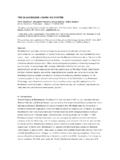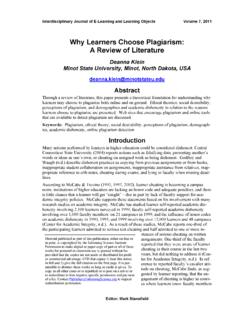Transcription of Fair Dealing in Canada - Canadian Association of Research ...
1 Myth: fair Dealing is a recent addition to the Copyright Dealing s origins can be traced back to English case law from the 18th century. In 1921, Canada s Copyright Act included fair Dealing as section (i), allowing fair Dealing for the purposes of private study, Research , criticism, review, or newspaper summary. The purposes of parody, satire and education were added to the Act in 2012. The addition of education was well received by the education sector, even though uses of fair Dealing within educational institutions (for the purposes of private study, Research , criticism, or review) were already well established, and had been confirmed by the courts to be valid : fair Dealing has a long history and has been a part of Canada s Copyright Act since : Copyright law does not provide clear guidance on fair number of court decisions have provided clear direction on the application of fair Dealing .
2 In particular, the Supreme Court of Canada s 2004 CCH Canadian Ltd. v. Law Society of Upper Canada decision provides six non-exhaustive factors (para 60)1 with which to determine the fairness of an intended use. These factors are: purpose, character, amount, alternatives, nature, and effect. The Supreme Court reasserted these six non-exhaustive factors in a set of decisions in 20122, such as education, journalism, and film production have developed best practices for applying fair Dealing based on this guidance. Fact: Court decisions have provided ample guidance when interpreting the Copyright Act s fair Dealing : The Copyright Act does not limit fair Dealing to any specific amount.
3 Myth: Under fair Dealing , only a small portion of a work can be copied. The Act states that copyright applies to uses of the work or any substantial part thereof. A substantial part of a work can be used under fair Dealing if it is for an allowable purpose and if the requirements of the Supreme Court of Canada s six-factor test1 for fairness are met. The amount is just one of these factors. Some clear standards have also been established. For example, the Copyright Board has stated that copying a page or two from a book (other than a book of short works) is not substantial and falls outside copyright (para 458)4, and that the use of up to 10 percent of a work does not affect the fairness of the Dealing .
4 (para 288). For uses that fall under fair Dealing , the Supreme Court has stated that for the purpose of Research or private study, it may be essential to copy an entire academic article or an entire judicial decision. (CCH, para 56) : The Supreme Court of Canada has made it clear that users and creators rights are equally important components of copyright. Myth: Copyright s primary purpose is to protect authors rights are extensive but limited. In the 2002 Th berge v. Galerie d Art du Petit Champlain inc. case, the Supreme Court of Canada stated that: The Copyright Act is usually presented as a balance between promoting the public interest in the encouragement and dissemination of works of the arts and intellect and obtaining a just reward for the creator (para 30)5.
5 In the CCH decision, the Supreme Court reiterated this statement (para 23)1 while also quoting Professor David Vaver6: User rights are not just loopholes. Both owner rights and user rights should therefore be given the fair and balanced reading that befits remedial legislation (para 48) Supreme Court of Canada reaffirmed the user rights concept in a set of decisions in 20122, Dealing in CanadaMyths & FactsFair Dealing is an important right that allows the use of copyright-protected material without permission from the copyright holder under certain circumstances.
6 To exercise this right appropriately, it is important to know the facts about fair : Canadian educational institutions application of fair Dealing is not respectful of the rights of educational institutions have adopted policies and services7 that ensure that they are both respectful of the law and provide fair compensation to copyright holders. These fair Dealing policies are consistent with recent Supreme Court and Copyright Board decisions. When amending the Copyright Act in 2012, the government stated that one of its goals was to allow educators and students to make greater use of copyright material 8.
7 The courts have also upheld the use of fair Dealing in : educational institutions have established policies that ensure fair Dealing is applied fairly and responsibly, in keeping with jurisprudence. Myth: The decline in profits of Canadian educational publishers is a result of Canadian educational institutions reliance on fair earnings by educational publishers is not unique to Canada ; it is a global trend reflecting digital-age market changes. The prevalence of open access to scholarly content and the increased availability of digital formats have decreased instructors reliance on print materials.
8 These factors, combined with student dissatisfaction with high textbook costs, have caused many instructors to move away from textbooks and course packs. This is often done in favour of open textbooks and open educational resources, which can be freely adapted by instructors and are more compatible with instructors current practices. Fact: The downturn in educational publisher income is due to a combination of global pressures, not a single factor. ^in EducationOriginally commissioned byFact: Post-secondary institutions continue to be among the biggest supporters of Canadian authors , especially scholarly libraries continue to spend hundreds of millions of dollars each year9 to purchase and license content, including Canadian content, to support their institutions teaching and Research goals.
9 For additional content required for specific courses, if the use of that content falls outside the scope of fair Dealing , then either the institution pays the copyright owner for the right to use the work or the students are asked to purchase a copy. Additionally, post-secondary institutions employ and support scholarly authors who write, provide peer review for, and submit works to commercial publishers, usually without remuneration from those publishers. These institutions also support new forms of scholarly publishing by funding university presses and providing electronic journal-hosting : Canadian universities are no longer doing their share to support Canadian to share and reuseThis version byFact: The changes in the Act in 2012 do not have any new impact on the amount of a work that can be copied under fair 2012 education was added to the Copyright Act as an allowable purpose for fair Dealing .
10 However, this had no impact on the standard of fairness to be applied. educational uses are still subject to a fair Dealing analysis, of which the amount copied is just one of the factors to be : The changes made to fair Dealing in the Copyright Act in 2012 gave educators the right to freely copy any amount of a adapted for the Canadian context by Lauren Byl at theOriginal design by1. CCH Canadian Ltd. v. Law Society of Upper Canada , [2004] 1 339, 2004 SCC Society of Composers, authors and Music Publishers of Canada v.









